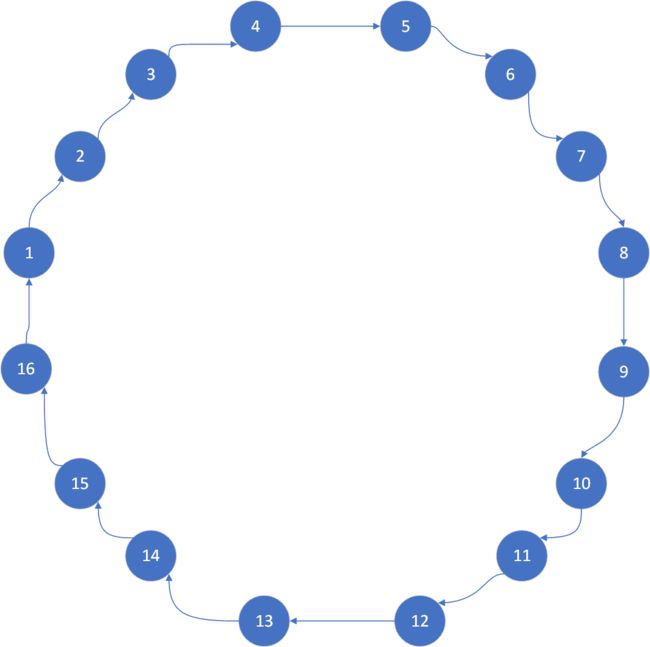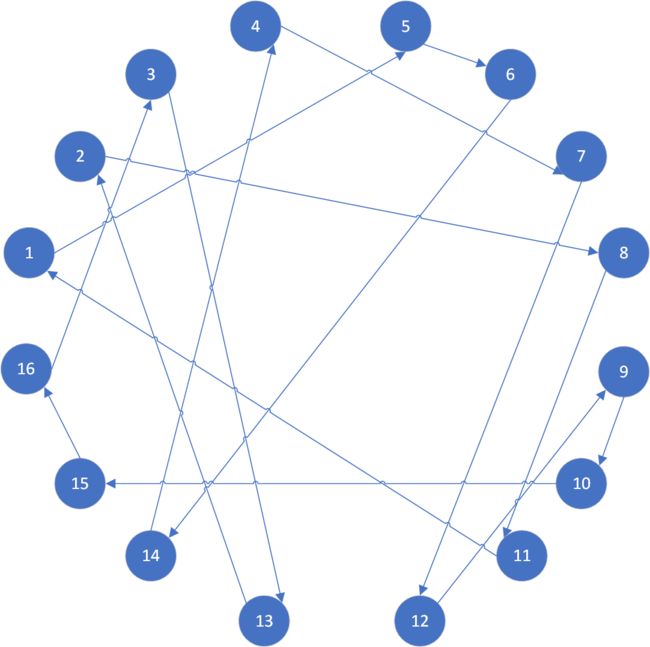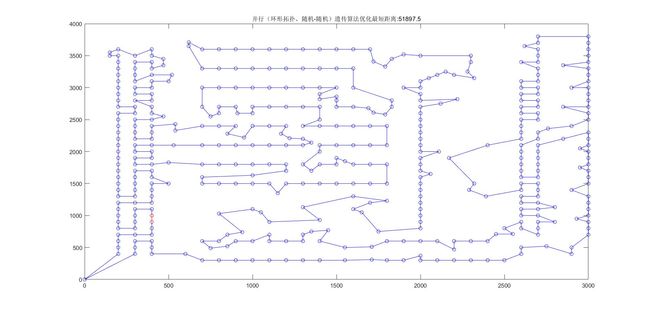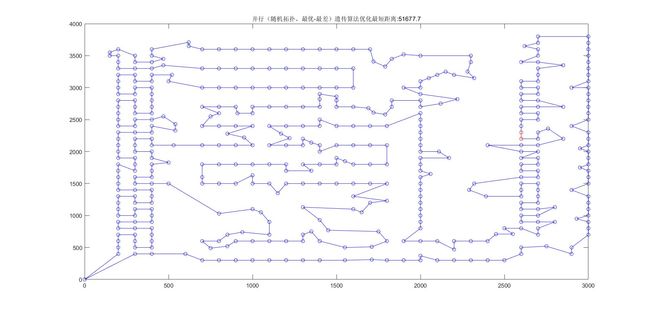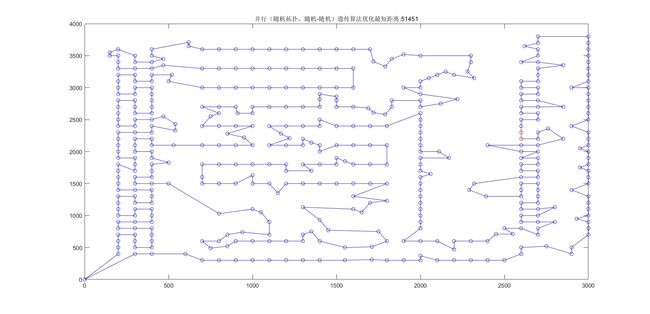利用改进的遗传算法(种群隔离与个体迁移)mpi并行解决tsp问题
序
关于tsp问题的概述以及如何使用遗传算法进行求解已经在上一篇文章中说明了:遗传算法解决TSP问题.
但是,作为一种演化算法,遗传算法还存在着许多问题,比如早熟的情况,很容易在算法前期就已经收敛了,大量的个体都趋向于一致,种群多样性降低。
这种情况下,就很容易陷入局部最优解。即使扩大迭代次数、种群中的个体数量,也是无济于事的。
一、优化思想
那如何进行优化呢?一种做法就是,进行种群隔离,既然一个种群会出现趋同的情况,那么我们就搞许多个种群。
如果这些种群之间不进行通信,那么是不是可以认为他们就属于两个物种呢?
如果这样的话,那么我们采用少量的个体交换,对于这些种群,他们的物种丰富度是不是就提高了?
所以,这篇文章采用并行计算的方法,我们搞16个种群,这些种群每迭代2000次进行一次个体交换,通过这种多次的交换,来丰富物种多样性。
二、迁移策略
但是,如何在16个种群间进行物种迁移呢?这就要考虑到他们迁移的拓扑结构。
2.1 环形拓扑
环形拓扑主要就是将一个种群中的某个个体迁移到其他种群中去,具体如下:
2.2 随机拓扑
随机拓扑是任意的,即:一个种群可以向其他任意种群中传递个体。如图:
看起来就很乱,而且每一次种群间交流完全都是随机的。
三、替换策略
确定了那两个种群进行交换后,如何确定交换种群中的那两个个体呢?
3.1 最优-最差替换
最优发送:即选择种群中的最优个体给其他种群。
最差替换:接收到个体的种群,用别人给的最优的,替换自己最差的个体(适应度值最小)。
3.2 随机-随机替换
随机发送:随机发送一个个体给其他种群。
随机替换:接收到其他种群发送过来的个体后,随机选择一个自己种群的个体替换掉。
四、代码实现
串行改并行,主要分为两个步骤来进行。
第一步就是写好串行的代码;
第二步把串行的代码改成并行的。
最后可能还要稍微改下bug。
4.1 串行代码
#pragma once
// 解决TSP问题的重构算法(主要是tsp0的代码风格太丑陋了,修改成C++风格)
#include4.2 并行代码
利用mpi编写的并行代码如下:
#include sendIndividualTo0 = tsp.getRandomIndividual();
// 向 0 号进程发送当前最优个体
MPI_Send(&sendIndividualTo0[0], numCity, MPI_INT, 0, 0, MPI_COMM_WORLD);
// 接收 0 号进程发送的最优个体
vector<int> recvIndividualFrom0(numCity);
MPI_Recv(&recvIndividualFrom0[0], numCity, MPI_INT, 0, 0, MPI_COMM_WORLD, MPI_STATUS_IGNORE);
// 替换掉当前最差个体
tsp.replaceWorstIndividual(recvIndividualFrom0);
// 随机替换一个个体
// tsp.replaceRandomIndividual(recvIndividualFrom0);
// 设置最大迭代次数 + 2000
tsp.setMaxGen(tsp.getMaxGen() + migrationInterval);
}
}
if (myrank == 0) {
// 用于接收其他进程发送的个体
vector<vector<int>> recvIndividuals(numProcess - 1, vector<int>(tsp.getNumCity()));
// 进行100轮分发
for (int i = 0; i < migrationTimes; i++) {
for (int j = 1; j < numProcess; j++) {
MPI_Recv(&recvIndividuals[j - 1][0], tsp.getNumCity(), MPI_INT, j, 0, MPI_COMM_WORLD, MPI_STATUS_IGNORE);
}
// 环形拓扑,将收到的个体按顺序传递给下一个进程
// 1 -> 2 -> 3 -> ... -> numProcess - 1 -> 1
//for (int j = 1; j < numProcess - 1; j++) {
// MPI_Send(&recvIndividuals[j - 1][0], tsp.getNumCity(), MPI_INT, j + 1, 0, MPI_COMM_WORLD);
//}
//MPI_Send(&recvIndividuals[numProcess - 2][0], tsp.getNumCity(), MPI_INT, 1, 0, MPI_COMM_WORLD);
// 随机拓扑,将收到的个体打乱顺序
vector<int> randomOrder(numProcess - 1);
for (int j = 0; j < numProcess - 1; j++) {
randomOrder[j] = j;
}
// 采用随机洗牌算法打乱顺序
random_shuffle(randomOrder.begin(), randomOrder.end());
// 将打乱顺序后的个体传递给农民进程
for (int j = 0; j < numProcess - 1; j++) {
MPI_Send(&recvIndividuals[randomOrder[j]][0], tsp.getNumCity(), MPI_INT, j + 1, 0, MPI_COMM_WORLD);
}
}
// 输出 recvIndividuals 中的最优个体
double bestFitness = tsp.calculateIndividualAdaptability(recvIndividuals[0]);
int bestIndividualIndex = 0;
for (int i = 1; i < numProcess - 1; i++) {
double fitness = tsp.calculateIndividualAdaptability(recvIndividuals[i]);
if (fitness < bestFitness) {
bestFitness = fitness;
bestIndividualIndex = i;
}
}
cout << "best fitness: " << bestFitness << endl;
//cout << "best individual: ";
// for (int i = 0; i < tsp.getNumCity(); i++) {
// cout << bestIndividuals[bestIndividualIndex][i] << " ";
// }
// 将最优个体写入文件
fstream outfile;
outfile.open("bestIndividual.txt", ios::out);
for (int i = 0; i < tsp.getNumCity(); i++) {
outfile << recvIndividuals[bestIndividualIndex][i] << " ";
}
outfile.close();
}
MPI_Finalize();
return 0;
}
五、结果分析与讨论
采用matlab对求解结果进行可视化,代码如下:
clear all; %清除所有变量
close all; %清图
clc; %清屏
C=load('./file/tsp442.txt');
R_best=load('./file/data/并行-随机拓扑-随机替换.txt');
n = size(C,1);
for i=1:n-1 % 绘制历代最优路线的图
plot([ C(R_best(i) + 1,1), C(R_best(i+1) + 1,1)],... % 绘制 n-1 条边
[C(R_best(i) + 1,2), C(R_best(i+1) + 1,2)],'bo-');
hold on;
end
plot([C(R_best(n) + 1,1), C(R_best(1) + 1,1)],... % 连接首尾边
[C(R_best(n) + 1,2), C(R_best(1) + 1,2)],'ro-');
% 串行 51509.1
% 并行(100轮、2000次、环形拓扑、最好-最差) 51617.3
% 并行(100轮、2000次、环形拓扑、随机-随机) 51897.5
% 并行(100轮、2000次、随机拓扑、最好-最差) 51677.7
% 并行(100轮、2000次、随机拓扑、随机-随机) 51451
title(['并行(随机拓扑、最优-最差)遗传算法优化最短距离:',num2str(51677.7)]);
5.1 串行求解结果
最优路线长度:51509.1
5.2 并行求解结果
| 种群交流方式 | ||
|---|---|---|
| 拓扑结构 | 环形拓扑 | 随机拓扑 |
| 替换策略 | 最优-最差 | 随机-随机 |
拓扑结构有2种选择,替换策略也有2种选择,因此,一共有4种组合方式。
5.2.1 环形拓扑、最优-最差
最优路线长度:51617.3
5.2.2 环形拓扑、随机-随机
最优路线长度:51897.5
5.2.3 随机拓扑、最优-最差
最优路线长度:51677.7
5.2.4 随机拓扑、随机-随机
最优路线长度:51451
5.3 结果分析
上述结果是在迭代200000次得到的结果,其中每2000次进行一次种群交流。
由于计算资源有限,没有进行大量实验,但由于迭代次数较大,实验结果应当是较为稳定的。
从有限的实验结果中可以看到,随机拓扑+随机替换策略,找到的解为51451,是更优的。
这也说明,我们通过种群间交流,主要目的就是增加种群的物种多样性,而通过两种随机的策略(随机拓扑+随机替换)相互结合,相比于(环形拓扑+最优替换)增大了种群交流的随机性,较好地利用了多个种群,所以产生了较好地效果。
